Geological Controlling Factors on Mississippi Valley-Type Pb-Zn Mineralization in Western Semnan, Iran
Abstract
:1. Introduction
2. Geological Framework of the Study Area
MVT Pb-Zn Mineralization in Western Semnan
| No. | Name | X in UTM | Y in UTM | Metal Associations | Host Rock |
|---|---|---|---|---|---|
| 1 | Chenaran | 53°10′15″ | 35°40′54″ | Lead | Limestone. Lar. Fm (Jurassic) |
| 2 | Darreh Ahu | 53°14′21″ | 35°43′31″ | Lead | Dolomite, limestone (Cretaceous) |
| 3 | Sarlash | 53°03′48″ | 35°48′15″ | Lead/Zinc | Limestone (Cretaceous) |
| 4 | Anabu | 53°03′55″ | 35°48′09″ | Lead/Zinc | Limestone (Cretaceous) |
| 5 | Kuh-e-Rudbar | 53°10′29″ | 35°40′55″ | Lead/Zinc | Limestone. Lar. Fm (Jurassic) |
| 6 | Abgarm | 53°11′20″ | 35°39′45″ | Lead/Zinc | Sandy limestone. Shahmirzad member (Jurassic) |
| 7 | Shahmirzad | 53°16′29″ | 35°43′54″ | Lead/Zinc | Limestone (Cretaceous) |
| 8 | Mehdi Shahr | 53°19′00″ | 35°45′00″ | Lead/Zinc | Limestone. Lar Fm (Jurassic) |
| 9 | Kuh-e-Bashm | 53°27′00″ | 35°49′59″ | Lead/Zinc | Limestone (Cretaceous) |
| 10 | Rezabarag | 53°28′18″ | 35°49′40″ | Lead/Zinc | Limestone (Cretaceous) |
| 11 | Sangsar | 53°19′59″ | 35°43′36″ | Lead and Zinc | Limestone. Elika Fm (Triassic) |
| 12 | Laveh dar | 53°22′00″ | 35°44′41″ | Lead and Zinc | Dolomite. Elika Fm (Triassic) |
| 13 | Darband Shahmirzad | 53°15′00″ | 35°45′00″ | Lead and Zinc | Limestone, dolomite. Elika Fm (Triassic) |
| 14 | Darband | 53°21′10″ | 35°44′54″ | Lead and Zinc | Limestone (Cretaceous) |
| 15 | Rezabark | 53°27′17″ | 35°49′40″ | Lead and Zinc | Limestone (Cretaceous) |
| 16 | Shahmirzad1 | 53°17′08″ | 35°44′14″ | Lead and Zinc | Limestone (Cretaceous) |
3. Material and Methods
3.1. Data Source
3.2. Fry Analysis
3.3. Distance Distribution Analysis
3.4. Random Forest (RF) Algorithm-Based Modeling
3.4.1. Hyperparameters for RF Analysis
3.4.2. Performance Metrics for Regressor RF
4. Analysis, Results, and Interpretation
4.1. Conceptual Modeling of Geologic Controls on MVT Pb-Zn Mineralization
- The presence of Permian–Cretaceous dolomite and limestone geological units as chemical and also physical traps.
- The presence of relative regular structure (NE–SW) faults/fractures and the confluence of the fault families for fluid migration from source to traps.
- The presence of fractures to provide a suitable path for the flow of fluids from the sedimentary basin.
4.2. MVT Pb-Zn Mineral Prospectivity Mapping (MPM)
4.2.1. Geochemical Signatures
- Fuzzified map of the proximity to the NE–SW trending fault (Figure 7a)
- Fuzzified map of the proximity to Permian–Cretaceous dolomite and limestone geological unit (Figure 7b)
- Fuzzified map of the geochemical information layer of Ba (Figure 8a)
- Fuzzified map of the geochemical information layer of Pb (Figure 8b)
- Fuzzified map of the geochemical information layer of Zn (Figure 8c)
4.2.2. Model Training
5. Discussion
6. Conclusions
Author Contributions
Funding
Data Availability Statement
Conflicts of Interest
References
- Sangster, D.F. Mississippi Valley-type and sedex lead-zinc deposits: A comparative examination. Inst. Min. Metall. Trans. 1990, 99, B21–B42. [Google Scholar]
- Goodfellow, W.D.; Lydon, J.W.; Turner, R.J.W. Geology and genesis of stratiform sediment-hosted (SEDEX) zinc-lead-silver sulphide deposits. Geol. Assoc. Can. Spec. Paper. 1993, 40, 201–251. [Google Scholar]
- Leach, D.L.; Bradley, D.; Lewchuk, M.T.; Symons, D.T.A.; de Marsily, G.; Brannon, J. Mississippi Valley-type lead-zinc deposits through geological time: Implications from recent age-dating research. Miner. Depos. 2001, 36, 711–740. [Google Scholar] [CrossRef]
- Leach, D.L.; Sangster, D.F.; Kelley, K.D.; Large, R.R.; Garven, G.; Allen, C.R.; Gutzmer, J.; Walters, S. Sediment-hosted lead-zinc deposits: A global perspective. Econ. Geol. 2005, 100, 561–608. [Google Scholar] [CrossRef]
- Goodfellow, W.D.; Lydon, J.W. Sedimentary-exhalative (SEDEX) deposits. In Mineral Deposits of Canada: A Synthesis of Major Deposit Types, District Metallogeny, the Evolution of Geological Provinces and Exploration Methods ; Goodfellow, W.D., Ed.; Geological Association of Canada, Mineral Deposits Division: New Québec, QC, Canada, Special Publication 5; 2007; pp. 163–183. Available online: https://www.mddgac.org/ (accessed on 1 September 2024).
- Leach, D.; Bradley, D.; Huston, D.; Pisarevsky, S.; Taylor, R.; Gardoll, S. Sediment-Hosted Lead-Zinc Deposits in Earth History. Econ. Geol. 2010, 105, 593–625. [Google Scholar] [CrossRef]
- Wilkinson, J.J. Sediment-Hosted Zinc-Lead Mineralization: Processes and Perspectives. In Treatise on Geochemistry: Second Edition; Elsevier: Amsterdam, The Netherlands, 2014; Chapter 13; pp. 219–249. [Google Scholar] [CrossRef]
- Rajabi, A. Metallogeny and Geology of Zinc-Lead Deposits with Sedimentary Host Rocks in Iran; University of Tehran: Tehran, Iran, 2021. [Google Scholar]
- Symons, D.T.; Arne, D. Paleomagnetic constraints on Zn–Pb ore genesis of the Pillara Mine, Lennard Shelf, Western Australia. Miner. Depos. 2005, 39, 944–959. [Google Scholar] [CrossRef]
- Paradis, S.; Hannigan, P.; Dewing, K. Mississippi Valley-type lead-zinc deposits. Geol. Assoc. Can. Miner. Depos. Div. Spec. Publ. 2007, 5, 185–203. [Google Scholar]
- Leach, D.L.; Taylor, R.D. Mississippi Valley-Type Lead-Zinc Deposit Model. In U.S. Geological Survey Open-File Report 2009-1213; USGS: Reston, VA, USA, 2009. [Google Scholar]
- Bradley, D.; Leach, D. Tectonic controls of Mississippi Valley-type lead–zinc mineralization in orogenic forelands. Miner. Deposita 2003, 38, 652–667. [Google Scholar] [CrossRef]
- Bazargani-Guilani, K.; Nekouvaght Tak, M.A.; Faramarzi, M. Pb-Zn deposits in Cretaceous carbonate host rocks, northeast Shahmirzad, central Alborz, Iran. Aust. J. Earth Sci. 2011, 58, 197–307. [Google Scholar] [CrossRef]
- Rajabi, A.; Rastad, E.; Canet, C. Metallogeny of Cretaceous carbonate-hosted Zn–Pb deposits of Iran: Geotectonic setting and data integration for future mineral exploration. Int. Geol. Rev. 2012, 54, 1649–1672. [Google Scholar] [CrossRef]
- Rajabi, A.; Rastad, E.; Canet, C. Metallogeny of Permian–Triassic carbonate-hosted Zn–Pb and F deposits of Iran: A review for future mineral exploration. Aust. J. Earth Sci. 2013, 60, 197–216. [Google Scholar] [CrossRef]
- He, Z.; Gao, J.; Li, S.; He, S. Mineralization of MVT Pb-Zn Deposits in the Process of Hydrocarbon Accumulation and Destruction in the Strong Structural Deformation Area of Eastern Sichuan, South China. Minerals 2022, 12, 1281. [Google Scholar] [CrossRef]
- Wang, G.; Lei, Q.; Huang, Z.; Liu, G.; Fu, Y.; Li, N.; Liu, J. Genetic Relationship between Mississippi Valley-Type Pb–Zn Mineralization and Hydrocarbon Accumulation in the Wusihe Deposits, Southwestern Margin of the Sichuan Basin, China. Minerals 2022, 12, 1447. [Google Scholar] [CrossRef]
- Guan, G.; Li, S.; Li, R. Mineralization Process of MVT Zn-Pb Deposit Promoted by the Adsorbed Hydrocarbon: A Case Study from Mayuan Deposit on the North Margin of Sichuan Basin. Minerals 2023, 13, 72. [Google Scholar] [CrossRef]
- Laranjeira, V.; Ribeiro, J.; Moreira, N.; Nogueira, P.; Flores, D. Geochemistry of Precambrian black shales from Ossa-Morena Zone (Portugal): Depositional environment and possible source of metals. J. Iber. Geol. 2023, 49, 1–19. [Google Scholar] [CrossRef]
- Parsa, M.; Maghsoudi, A. Controls on Mississippi Valley-Type Zn-Pb mineralization in Behabad district, Central Iran: Constraints from spatial and numerical analyses. J. Afr. Earth Sci. 2018, 140, 189–198. [Google Scholar] [CrossRef]
- Gibson, G.M.; Edwards, S. Basin inversion and structural architecture as constraints on fluid flow and Pb–Zn mineralization in the Paleo–Mesoproterozoic sedimentary sequences of northern Australia. Solid Earth 2020, 11, 1205–1226. [Google Scholar] [CrossRef]
- Bowness, N.P.; Cawood, A.J.; Ferrill, D.A.; Smart, K.J.; Bellow, H.B. Mineralogy controls fracture containment in mechanically layered carbonates. Geol. Mag. 2022, 159, 1855–1873. [Google Scholar] [CrossRef]
- Chi, G.; Xue, C. Similarities and Differences between the Sandstone-Hosted Jinding Zn-Pb Deposit and MVT Deposits. AGU Spring Meet. Abstr. 2009, MA73C-07. [Google Scholar]
- Ma, R. Study on geological features and exploration methods of MVT Pb-Zn deposits. IOP Conf. Ser. Earth Environ. Sci. 2018, 108, 032010. [Google Scholar] [CrossRef]
- Liu, Y.; Yang, Z.; Yue, L.; Yu, Y.; Ma, W.; Tang, B. Geological Characteristics and Genesis of the Jiamoshan MVT Pb–Zn Deposit, Sanjiang belt, Tibetan Plateau. Acta Geol. Sin. Engl. Ed. 2020, 94. [Google Scholar] [CrossRef]
- Garven, G. The role of regional fluid flow in the genesis of the Pine Point deposit, Western Canada Sedimentary Basin. Econ. Geol. 1985, 80, 307–324. [Google Scholar] [CrossRef]
- Ge, S.; Garven, G. Hydromechanical modeling of tectonically-driven groundwater flow with application to the Arkoma foreland basin. J. Geophys. Res. 1992, 97, 9119–9144. [Google Scholar] [CrossRef]
- Appold, M.S.; Garven, G. The hydrology of ore formation in the Southeast Missouri District: Numerical models of topography-driven fluid flow during the Ouachita Orogeny. Econ. Geol. 1999, 94, 913–936. [Google Scholar] [CrossRef]
- Bazargani-Guilani, K.; Faramarzi, M.; Tak, M. Multistage dolomitization in the Cretaceous carbonates of the east Shahmirzad area, north Semnan, central Alborz, Iran. Carbonates Evaporites 2010, 25, 177–191. [Google Scholar] [CrossRef]
- Bazargani-Guilani, K.; Rabiei, M.; Mehrabi, B. Effects of host rock mineralogical composition and sedimentary facies on development of geochemical halos in Shahmirzad Pb-Zn deposits, central Alborz, Iran. J. Geochem. Explor. 2013, 124, 155–165. [Google Scholar] [CrossRef]
- Fry, N. Random point distributions and strain measurement in rocks. Tectonophysics 1979, 60, 89–105. [Google Scholar] [CrossRef]
- Vearncombe, J.; Vearncombe, S. The spatial distribution of mineralization; applications of Fry analysis. Econ. Geol. 1999, 94, 475–486. [Google Scholar] [CrossRef]
- Berman, M. Distance distributions associated with Poisson processes of geometric figures. J. Appl. Probab. 1977, 14, 195–199. [Google Scholar] [CrossRef]
- Carranza, E.J.M. Controls on mineral deposit occurrence inferred from analysis of their spatial pattern and spatial association with geological features. Ore Geol. Rev. 2009, 35, 383–400. [Google Scholar] [CrossRef]
- Assereto, R. The Paleozoic formations in central Elburz (Iran) (preliminary note). Riv. Ital. Paleontol. Stratigr. 1963, 69, 503–543. [Google Scholar]
- Stöcklin, J.; Ruttner, A.; Nabavi, M. New Data on the Lower Paleozoic and Pre-Cambrian of North Iran; Geological Survey of Iran: Tehran, Iran, 1964; Volume 1. [Google Scholar]
- Geyer, G.; Bayet-Goll, A.; Wilmsen, M.; Mahboubi, A.; Moussavi-Harami, R. Lithostratigraphic revision of the middle Cambrian (Series 3) and upper Cambrian (Furongian) in northern and central Iran. Newsl. Stratigr. 2014, 47, 21–59. [Google Scholar] [CrossRef]
- Berberian, M. The southern Caspian: A compressional depression floored by a trapped modified oceanic crust. Can. J. Earth Sci. 1983, 20, 163–183. [Google Scholar] [CrossRef]
- Alavi, M. Sedimentary and structural characteristics of the Paleo-Tethys remnants in northeastern Iran. Geol. Soc. Am. Bull. 1991, 103, 983–992. [Google Scholar] [CrossRef]
- Alavi, M. Tectono-stratigraphic synthesis and structural style of the Alborz Mountain system in northern Iran. J. Geodyn. 1996, 21, 1–33. [Google Scholar] [CrossRef]
- Axen, G.J.; Lam, P.S.; Grove, M.; Stockli, D.F.; Hassanzadeh, J. Exhumation of the west-central Alborz Mountains, Iran, Caspian subsidence, and collision-related tectonics. Geology 2001, 29, 559–562. [Google Scholar] [CrossRef]
- Guest, B.; Stockli, D.F.; Grove, M.; Axen, G.J.; Lam, P.S.; Hassanzadeh, J. Thermal histories from the central Alborz Mountains, northern Iran: Implications for the spatial and temporal distribution of deformation in north Iran. Geol. Soc. Am. Bull. 2006, 118, 1507–1521. [Google Scholar] [CrossRef]
- David, L.; Taylor, R.D.; Fey, D.L.; Diehl, S.F.; Saltus, R.W. A Deposit Model for Mississippi Valley-Type Lead-Zinc Ores. Mineral Deposit Models for Resource Assessment; Scientific Investigations Report 2010–5070–K; USGS: Reston, VA, USA, 2010.
- Bigdeli, A.; Maghsoudi, A.; Ghezelbash, R. Recognizing geochemical anomalies associated with mineral resources using singularity analysis and random forest models in the Torud-Chahshirin Belt, Northeast Iran. Minerals 2023, 13, 1399. [Google Scholar] [CrossRef]
- Tabatabaei, S.H.; Rodsari, P.R.; Mokhtari, A.R. Predicting Potential Mineralization Using Surface Geochemical Data and Multiple Linear Regression Model in the Kuh Panj Porphyry Cu Mineralization (Iran). Arab. J. Sci. Eng. 2015, 40, 163–170. [Google Scholar] [CrossRef]
- Chen, Y.; Wu, W. Application of one-class support vector machine to quickly identify multivariate anomalies from geochemical exploration data. Geochem. Explor. Environ. Anal. 2017, 17, 231–238. [Google Scholar] [CrossRef]
- Grunsky, E.; Caritat, P.D. State-of-the-Art Analysis of Geochemical Data for Mineral Exploration. Geochem. Explor. Environ. Anal. 2019, 20, geochem2019-031. [Google Scholar] [CrossRef]
- Li, C.; Liu, B.; Guo, K.; Li, B.; Kong, Y. Regional Geochemical Anomaly Identification Based on Multiple-Point Geostatistical Simulation and Local Singularity Analysis—A Case Study in Mila Mountain Region, Southern Tibet. Minerals 2021, 11, 1037. [Google Scholar] [CrossRef]
- Ghasemi, R.; Tokhmechi, B.; Borg, G. Evaluation of effective factors in window optimization of fry analysis to identify mineralization pattern: Case study of Bavanat region, Iran. J. Min. Environ. 2017, 9, 195–208. [Google Scholar] [CrossRef]
- Nguemhe Fils, S.C.; Mimba, M.; Nyeck, B.; Nforba, M.; Boniface, K.; Nouck, P.; Hell, J. GIS-Based Spatial Analysis of Regional-Scale Structural Controls on Gold Mineralization Along the Bétaré-Oya Shear Zone, Eastern Cameroon. Nat. Resour. Res. 2020, 29, 3457–3477. [Google Scholar] [CrossRef]
- Ghasemzadeh, S.; Maghsoudi, A.; Yousefi, M.; Mihalasky, M.J. Recognition and incorporation of mineralization-efficient fault systems to produce a strengthened anisotropic geochemical singularity. J. Geochem. Explor. 2022, 235, 106967. [Google Scholar] [CrossRef]
- Breiman, L. Random Forests. Mach. Learn. 2001, 45, 5–32. [Google Scholar] [CrossRef]
- Carranza, E.J.M.; Laborte, A. Data-driven predictive mapping of gold prospectivity, Baguio district, Philippines: Application of Random Forests algorithm. Ore Geol. Rev. 2014, 71, 777–787. [Google Scholar] [CrossRef]
- Xiang, J.; Xiao, K.; Carranza, E.J.M.; Jianping, C.; Li, S. 3D Mineral Prospectivity Mapping with Random Forests: A Case Study of Tongling, Anhui, China. Nat. Resour. Res. 2019, 29, 395–414. [Google Scholar] [CrossRef]
- Kuhn, S.D. Machine learning for mineral exploration: Prediction and quantified uncertainty at multiple exploration stages. Ph.D. Thesis, University of Tasmania, Hobart, Australia, 2021. [Google Scholar] [CrossRef]
- Zuo, R.; Carranza, E.J.M. Machine Learning-Based Mapping for Mineral Exploration. Math. Geosci. 2023, 55, 891–895. [Google Scholar] [CrossRef]
- Breiman, L. Classification and Regression Trees; CRC Press: Boca Raton, FL, USA, 1984. [Google Scholar]
- Carranza, E.J.M.; Hale, M. Where are porphyry copper deposits spatially localized? A case study in Benguet province, Philippines. Nat. Resour. Res. 2002, 11, 45–59. [Google Scholar] [CrossRef]
- Bishop, C.M. Pattern Recognition and Machine Learning; Springer Science Business Media: New York, NY, USA, 2006. [Google Scholar]
- Theodoridis, S.; Koutroumbas, K. Clustering: Basic concepts. Pattern Recogn. 2006, 483–516. [Google Scholar]
- Carranza, E.J.M. Geochemical Anomaly and Mineral Prospectivity Mapping in GIS. In Handbook of Exploration and Environmental Geochemistry; Elsevier: Amsterdam, The Netherlands, 2008; Volume 11. [Google Scholar]
- Yousefi, M.; Kamkar-Rouhani, A.; Carranza, E.J.M. Application of staged factor analysis and logistic function to create a fuzzy stream sediment geochemical evidence layer for mineral prospectivity mapping. Geochem. Explor. Environ. Anal. 2014, 14, 45–58. [Google Scholar] [CrossRef]
- Yousefi, M.; Carranza, E.J.M. Prediction-area (P-A) plot and C-A fractal analysis to classify and evaluate evidential maps for mineral prospectivity modeling. Comput. Geosci. 2015, 79, 69–81. [Google Scholar] [CrossRef]
- Mutele, L.; Billay, A.; Hunt, J.P. Knowledge-driven prospectivity mapping for granite-related polymetallic Sn–F–(REE) mineralization. Bushveld Igneous Complex, South Africa. Nat. Resour. Res. 2017. [Google Scholar] [CrossRef]
- Nykänen, V.; Niiranen, T.; Molnár, F.; Lahti, I.; Korhonen, K.; Cook, N.; Skyttä, P. Optimizing a Knowledge-driven Prospectivity Model for Gold Deposits Within Peräpohja Belt, Northern Finland. Nat. Resour. Res. 2017, 26, 571–584. [Google Scholar] [CrossRef]
- Bigdeli, A.; Maghsoudi, A.; Ghezelbash, R. Application of self-organizing map (SOM) and K-means clustering algorithms for portraying geochemical anomaly patterns in Moalleman district, NE Iran. J. Geochem. Explor. 2022, 233, 106923. [Google Scholar] [CrossRef]
- Ghasemzadeh, S.; Maghsoudi, A.; Yousefi, M.; Mihalasky, M.J. Information value-based geochemical anomaly modeling: A statistical index to generate enhanced geochemical signatures for mineral exploration targeting. Appl. Geochem. 2022, 136, 105177. [Google Scholar] [CrossRef]
- Meyer, C. Ore-forming processes in geologic history. Econ. Geol. 1981, 75, 6–41. [Google Scholar] [CrossRef]
- Meyer, C. Ore deposits as guides to geologic history of the earth. Annu. Rev. Earth Planet. Sci. 1988, 16, 147–171. [Google Scholar] [CrossRef]
- Sawkins, F.J. Metal Deposits in Relation to Plate Tectonics; Springer: Berlin, Germany, 1984; Volume 17. [Google Scholar]
- Veizer, J.; Laznicka, P.; Jansen, S.L. Mineralization through geologic time: Recycling perspective. Am. J. Sci. 1989, 289, 484–524. [Google Scholar] [CrossRef]
- Barley, M.E.; Groves, D.I. Supercontinent cycles and the distribution of metal deposits through time. Geology 1992, 20, 291–294. [Google Scholar] [CrossRef]
- Hutchinson, R.W. Mineral deposits and metallogeny: Indicators of Earth’s evolution. In Early Organic Evolution: Implications for Mineral and Energy Resources; Schidlowski, M., Ed.; Springer: Berlin, Heidelberg, Germany, 1992; pp. 521–544. [Google Scholar]
- Titley, S.R. Relationship of strata bound ores with tectonic cycles of the Phanerozoic and Proterozoic. Precambrian Res. 1993, 61, 295–322. [Google Scholar] [CrossRef]
- Goldfarb, R.J.; Groves, D.I.; Gardoll, S. Rotund versus skinny orogens: Well-nourished or malnourished gold? Geology 2001, 29, 539–542. [Google Scholar] [CrossRef]
- Groves, D.I.; Vielreicher, R.M.; Goldfarb, R.J.; Condie, K.C. Controls on the heterogeneous distribution of mineral deposits through time. Geol. Soc. Lond. Spec. Publ. 2005, 248, 71–101. [Google Scholar] [CrossRef]
- Holland, H.D. Sedimentary mineral deposits and the evolution of Earth’s near-surface environments. Econ. Geol. 2005, 100, 1489–1509. [Google Scholar] [CrossRef]
- Bigdeli, A.; Maghsoudi, A.; Ghezelbash, R. A comparative study of the XGBoost ensemble learning and multilayer perceptron in mineral prospectivity modeling: A case study of the Torud-Chahshirin belt, NE Iran. Earth Sci. Inform. 2024, 17, 483–499. [Google Scholar] [CrossRef]
- Yousefi, M.; Kreuzer, O. Towards an effective exploration information system–new concepts and ideas aimed at improving mineral exploration targeting. Appl. Geochem. 2024, 106053. [Google Scholar] [CrossRef]
- Yousefi, M.; Lindsay, M.D.; Kreuzer, O.P. Mitigating uncertainties in mineral exploration targeting: Majority voting and confidence index approaches in the context of an Exploration Information System (EIS). Ore Geol. Rev. 2024, 165, 105930. [Google Scholar] [CrossRef]
- Al-Khdheeawi, E.A.; Allawi, R.H.; Al-Rubaye, W.I.; Iglauer, S. A New Approach to Predicting Vertical Permeability for Carbonate Rocks in the Southern Mesopotamian Basin. Minerals 2023, 13, 1519. [Google Scholar] [CrossRef]
- Paradis, S.; Hannigan, P.; Dewing, K. Mineral Deposits of Canada: Mississippi Valley-type Lead-Zinc Deposits (MVT); Geological Survey of Canada: Ottawa, ON, Canada, 2008. [Google Scholar]
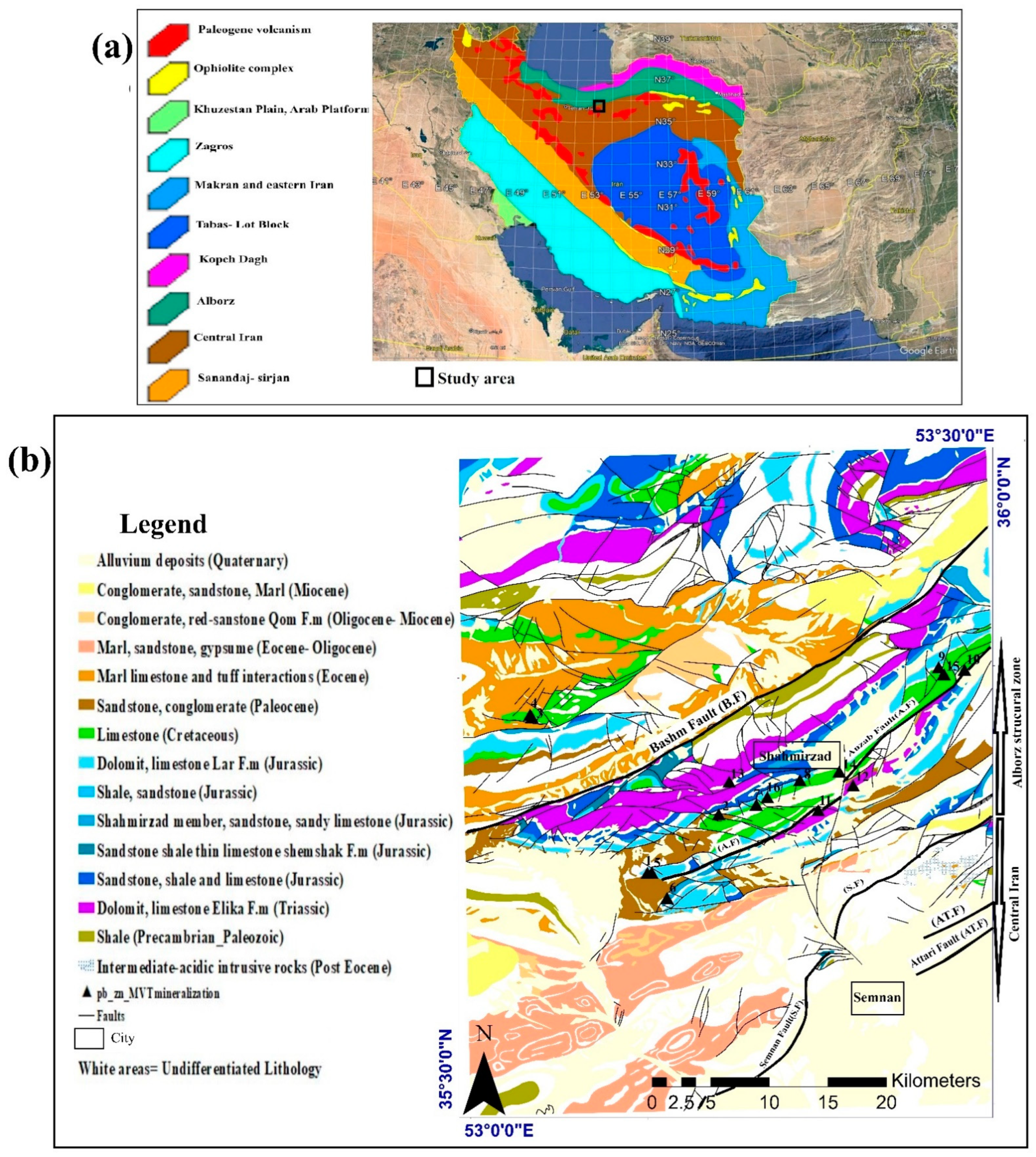


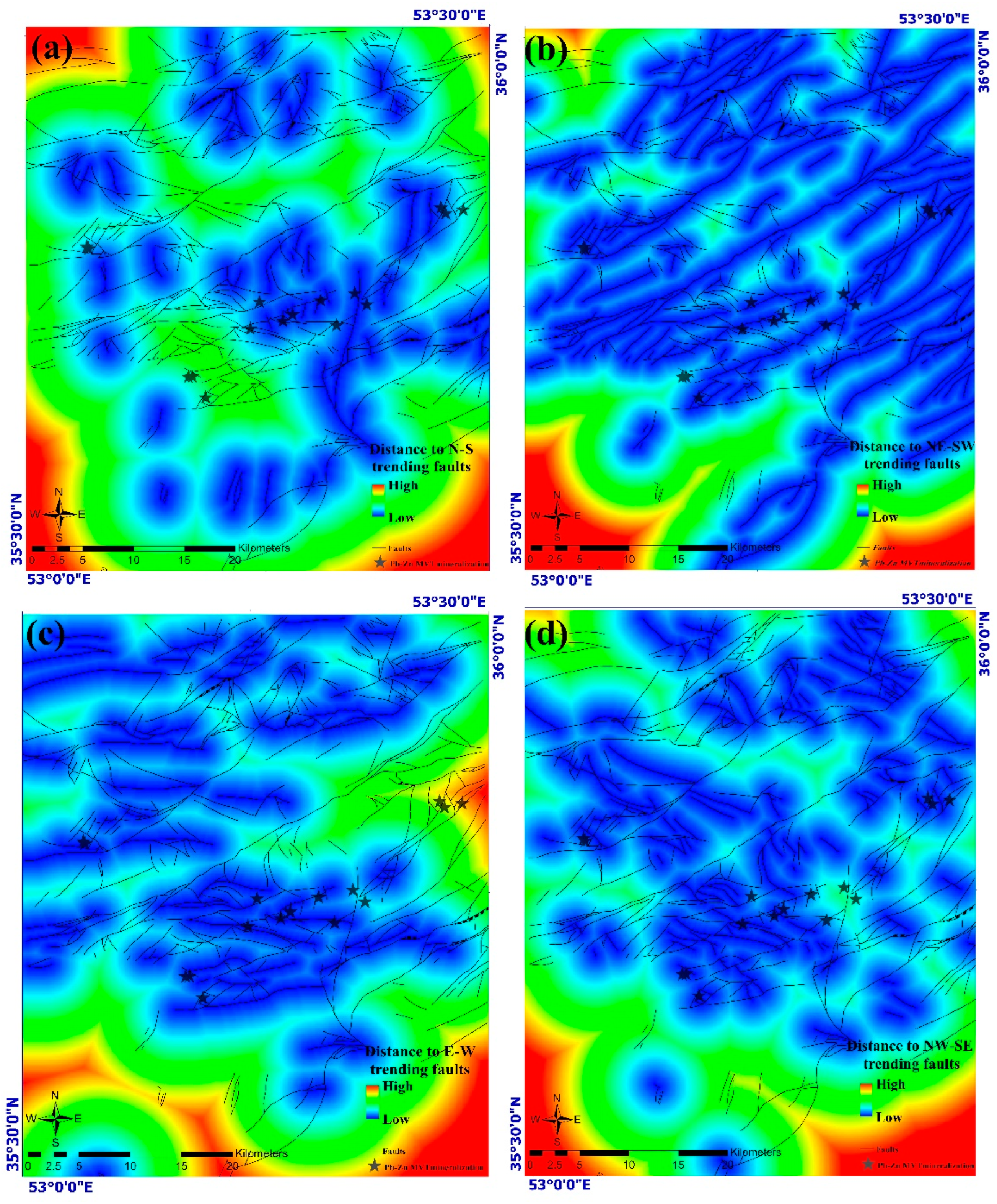
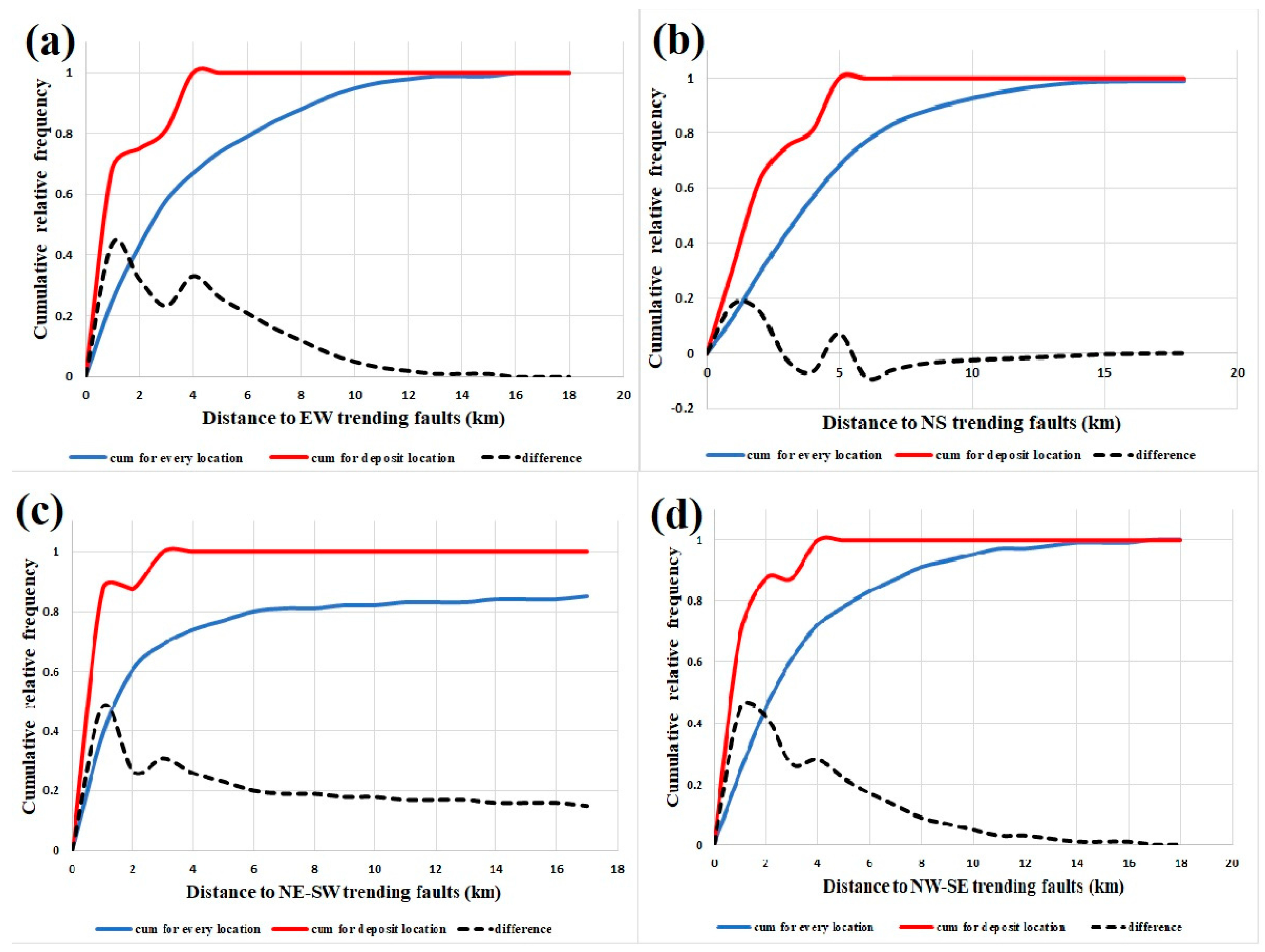
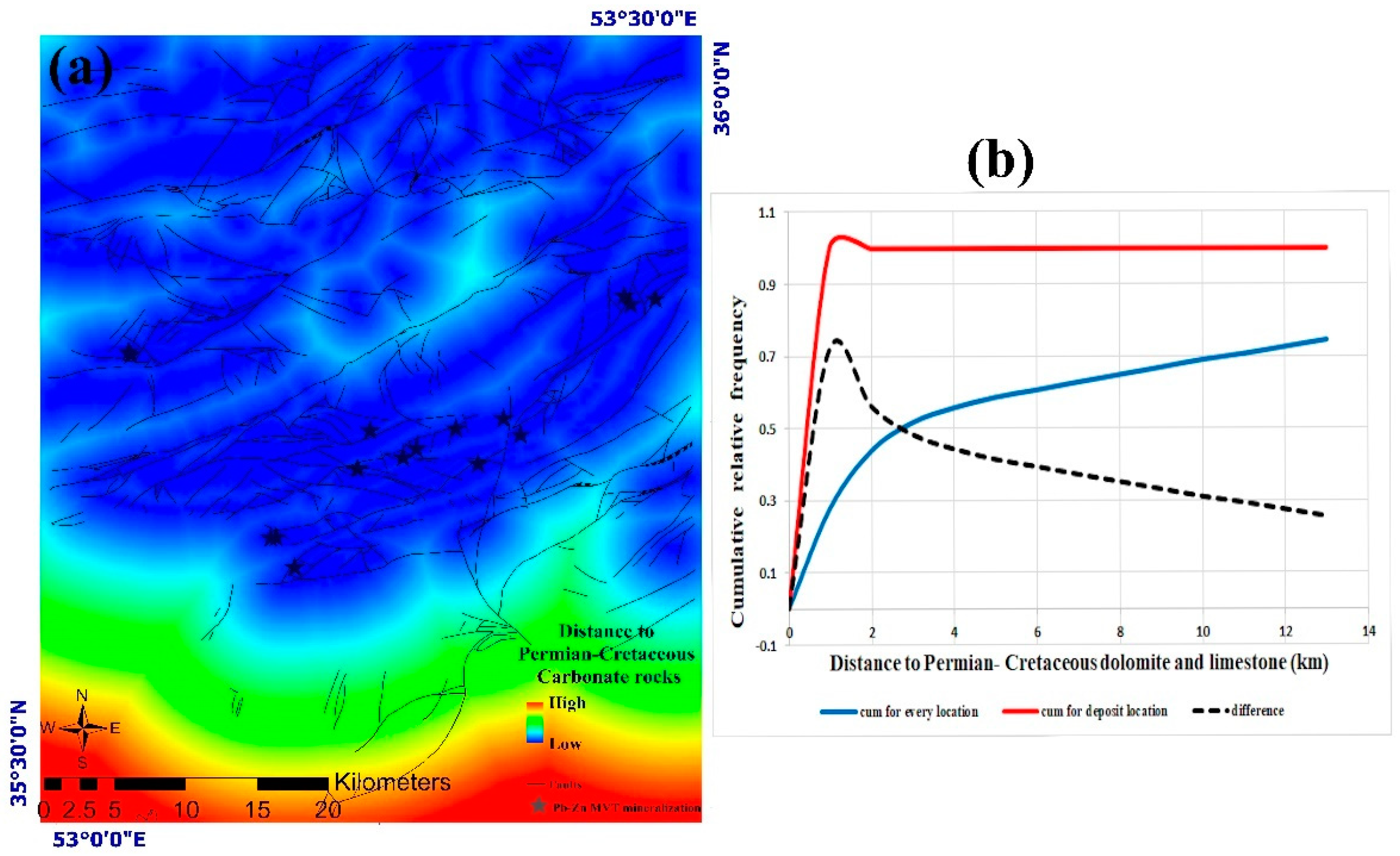
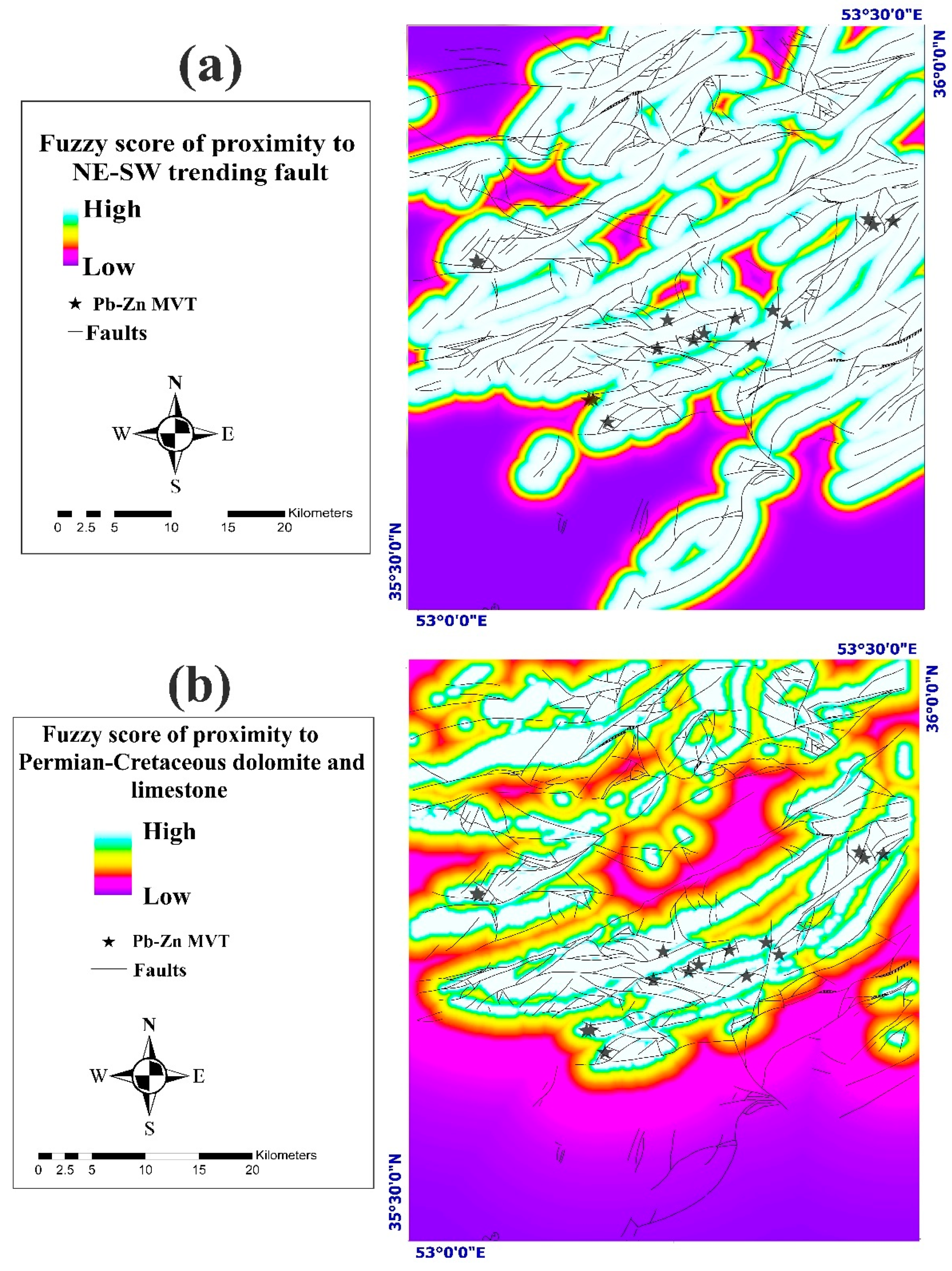

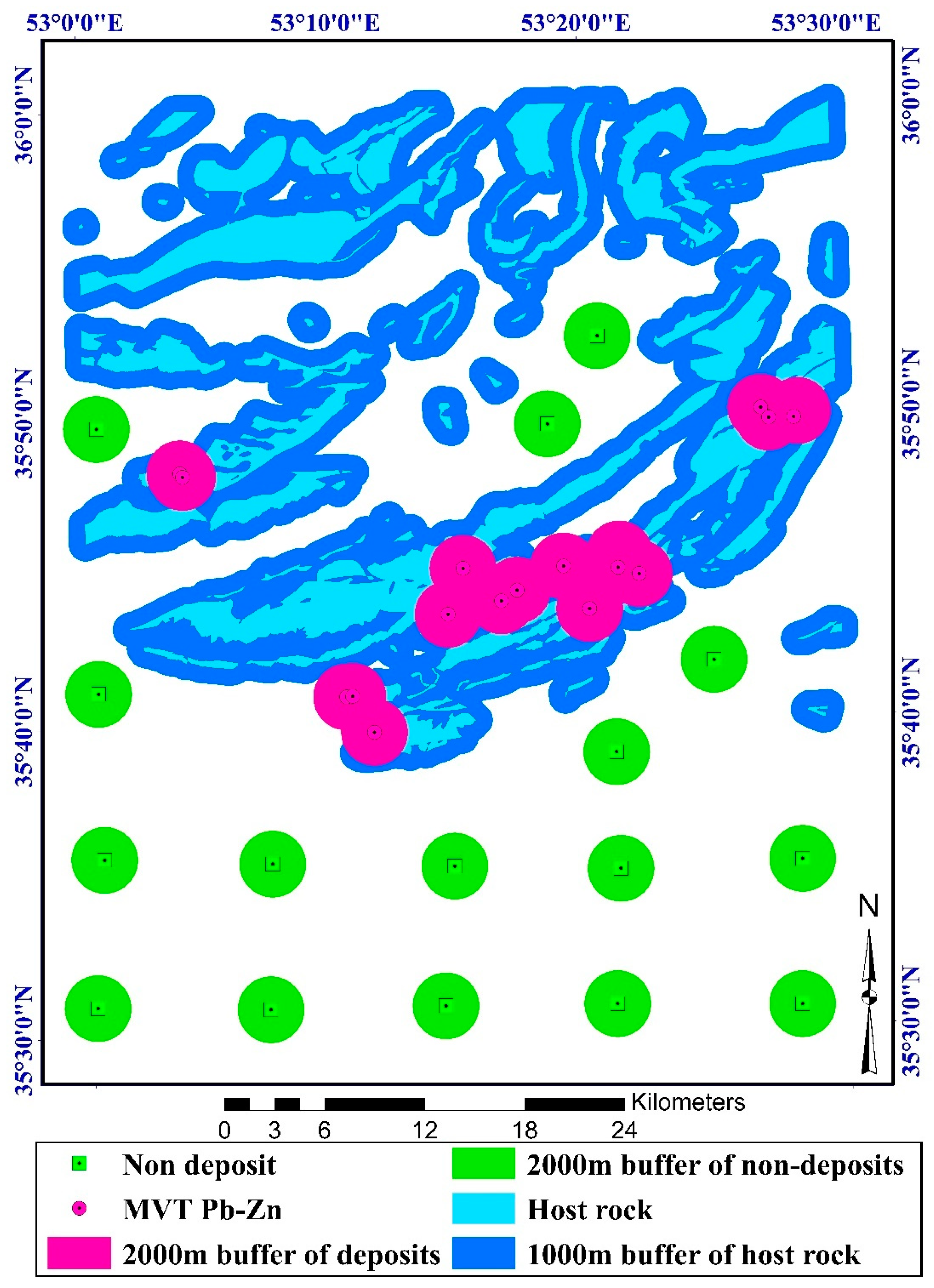
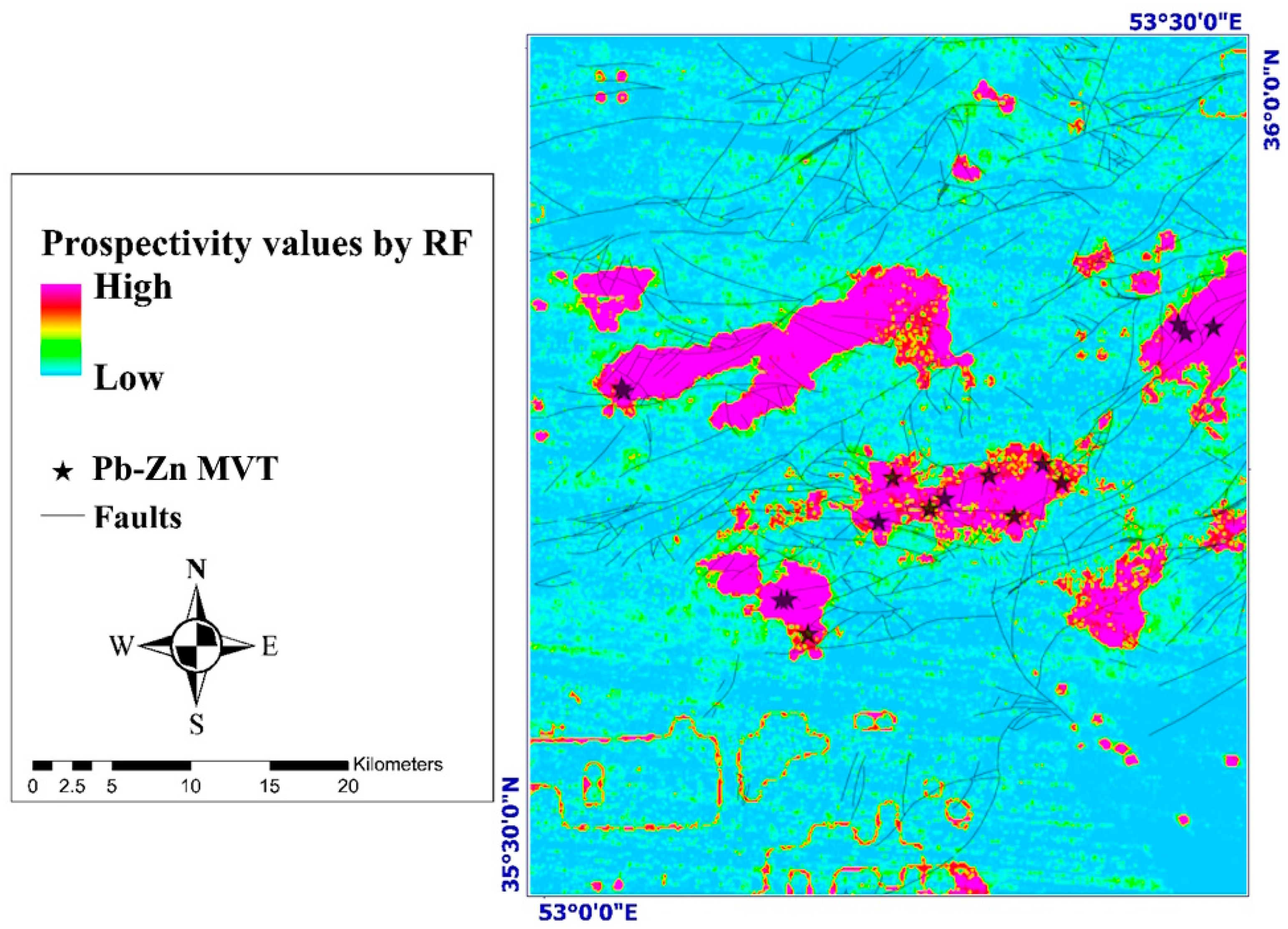
| Geological Features | Maximum Contrast Value, Cmax |
|---|---|
| NS striking faults | 0.18 |
| EW striking faults | 0.43 |
| NW–SE striking faults | 0.44 |
| NE–SW striking faults | 0.49 |
| Permian–Cretaceous dolomites and limestone units | 0.72 |
| Predictor | Membership Function |
|---|---|
| Proximity to NE–SW trending faults | Small |
| proximity to Permian–Cretaceous dolomite and limestone geological unit | Small |
| Pb distribution layer | MS Large |
| Zn distribution layer | MS Large |
| Ba distribution layer | MS Large |
| Hyperparameter | Value |
|---|---|
| Number of Estimators | 200 |
| Random State | 0 |
| Performance Metric | Value |
|---|---|
| Mean Absolute Error | 0.06 |
| Root Mean Squared Error | 0.14 |
| R-squared (R2) Score | 0.82 |
Disclaimer/Publisher’s Note: The statements, opinions and data contained in all publications are solely those of the individual author(s) and contributor(s) and not of MDPI and/or the editor(s). MDPI and/or the editor(s) disclaim responsibility for any injury to people or property resulting from any ideas, methods, instructions or products referred to in the content. |
© 2024 by the authors. Licensee MDPI, Basel, Switzerland. This article is an open access article distributed under the terms and conditions of the Creative Commons Attribution (CC BY) license (https://creativecommons.org/licenses/by/4.0/).
Share and Cite
Qaderi, S.; Maghsoudi, A.; Pour, A.B.; Yousefi, M. Geological Controlling Factors on Mississippi Valley-Type Pb-Zn Mineralization in Western Semnan, Iran. Minerals 2024, 14, 957. https://doi.org/10.3390/min14090957
Qaderi S, Maghsoudi A, Pour AB, Yousefi M. Geological Controlling Factors on Mississippi Valley-Type Pb-Zn Mineralization in Western Semnan, Iran. Minerals. 2024; 14(9):957. https://doi.org/10.3390/min14090957
Chicago/Turabian StyleQaderi, Soran, Abbas Maghsoudi, Amin Beiranvand Pour, and Mahyar Yousefi. 2024. "Geological Controlling Factors on Mississippi Valley-Type Pb-Zn Mineralization in Western Semnan, Iran" Minerals 14, no. 9: 957. https://doi.org/10.3390/min14090957
APA StyleQaderi, S., Maghsoudi, A., Pour, A. B., & Yousefi, M. (2024). Geological Controlling Factors on Mississippi Valley-Type Pb-Zn Mineralization in Western Semnan, Iran. Minerals, 14(9), 957. https://doi.org/10.3390/min14090957







